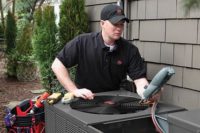As the government continues to aggressively regulate refrigerants, compressor manufacturers are actively evaluating alternative refrigerants for refrigeration applications. As they research the viability of low-GWP and other natural refrigerants, they face the concurrent challenges of ensuring compressors are efficient, safe, and reliable.
REGULATORY IMPACT
According to Rajan Rajendran, vice president, systems innovation and sustainability, Emerson Climate Technologies Inc., regulatory actions from the U.S. Environmental Protection Agency (EPA) and the U.S. Department of Energy (DOE) are pressuring the industry to transition to low-GWP (global warming potential) refrigerants.
“The EPA has come out with aggressive guidelines to move to low-GWP refrigerants through its recent SNAP [Significant New Alternatives Policy] program rulings,” Rajendran said. “The DOE’s energy-efficiency mandates have also added major implications to the industry.”
Looking back, the industry deserves a pat on the back for what it’s accomplished so far, Rajendran said.
“The industry should really be applauded for the achievements it’s made over the last 20 years in moving away from HCFCs [hydrochlorofluorocarbons],” he said.
But, there are still substantial challenges ahead as the refrigerant landscape continues to shift.
“We’re taking a bigger leap to low-GWP and other natural refrigerants. It’s a significant challenge to the refrigeration industry in respect to the cost of equipment, service, and operation, and there’s a lot more that we have to work through,” Rajendran said.
Mark Menzer, director of public affairs for Danfoss, noted the current pace of regulatory change makes it even more challenging for the industry to adjust.
“The rate of regulatory changes is creating an enormous burden for the industry,” Menzer said. “We are concerned with the speed of change and the ability of smaller OEMs to react to both the EPA SNAP rules on new refrigerants and the DOE’s minimum efficiency requirements.”
In addition to the mandates from government agencies, Doug Schmidt, commercial sales manager, Embraco North America, pointed out that corporations are also pushing for alternative refrigerants as they set goals to be more green and save power and money.
All of this has resulted in “another era in refrigerant evolution,” according to Schmidt. One development he has recently observed is that light commercial OEMs have put in place programs to understand the system changes required to utilize alternative refrigerants.
“From the compressor side, Embraco is evaluating these options,” Schmidt said. “While we previously designed products for HFCs [hydrofluorocarbons] and then adapted them to HCs [hydrocarbons] or HFOs [hydrofluoroolefins], we now optimize our designs for HCs and then consider the other options.”
Joe Sanchez, engineering manager, Bitzer US Inc., noted as manufacturers navigate the changing landscape, they must continue to consider all facets of their products.
“Efficiency is always a concern, but so is having a wide range of low-cost, reliable, quiet, and smooth-running compressors,” Sanchez said. “All of this must be evaluated as the industry’s needs evolve.”
ALTERNATIVE OPTIONS AND CHALLENGES
Currently, compressor manufacturers are working hard to test and approve new refrigerants while paying special attention to the challenges associated with low-GWP options.
Dean Groff, regional marketing manager, refrigeration, Danfoss, discussed some of the most popular alternatives currently being considered.
“The industry is evaluating a range of alternatives, including R-448A and R-449A as R-404A replacements, and R-450A and R-513A as replacements for R-134a,” he said. “Some are looking at propane [R-290] for smaller systems. R-452A is also being considered for transport refrigeration systems, or applications where a closer property match to R-404A is critical. Some of these same alternatives are also being considered as possible R-22 or HFC retrofit fluids, particularly in supermarket refrigeration.”
Because the evaluation of alternative refrigerants is ongoing, industry members are encouraged to check compressor manufacturers’ websites for the latest updates on which refrigerants are approved for which applications. For an example of the refrigerants Danfoss has approved and is currently reviewing, see Figure 1 above.
As the evaluations continue, Keith Gifford, director, global product management, Tecumseh Products Co., said there are a number of crucial issues that compressor manufacturers are working through.
“Specific to hydrocarbons and HFOs, all electrical components must be non-sparking. Additionally, in order to take advantage of the refrigerant properties, some changes must be made to a compressor’s gas-handling system. Specific to HFOs, which have a high refrigerant glide, care must be taken to ensure that compressor discharge temperatures do not exceed operating limits.”
Tecumseh publishes policy bulletins and application guidelines containing the requirements for compliance that enable its compressors to be safely used with alternative refrigerants.
One of the natural refrigerants that has been gaining popularity, despite its accompanying safety concerns, is R-290.
“R-290 has seemingly leapfrogged over many as the movement from HCFCs and HFCs grows,” Rajendran said. “Our R-290 reciprocating compressor, designed for specific use with propane and delivering up to 10 percent EER improvement, was recently featured at the AHR Expo.”
Rajendran noted R-290 is not a drop-in refrigerant and is also classified as A3, meaning it’s extremely flammable. (For a closer look at the characteristics of R-290, see the sidebar on Page 20.)
“Technicians and carriers throughout the supply chain who are handling propane need to have the proper training and certifications,” Rajendran said.
Schmidt added he’s also seen a lot of R-290 activity in both low- and medium-temperature applications. “This natural gas offers improved efficiency, cooling capacity, and opportunities for reduced system cost,” he said.
Other natural refrigerants that are becoming more popular include CO2 and ammonia. Sanchez said Bitzer has approved CO2, ammonia, and HCs for dedicated compressors that cover a wide range of applications.
“It became clear over a decade ago that CO2 has an undeniable future in low-temperature refrigeration,” Sanchez said, noting that CO2 requires the development of a completely redesigned compressor that has much higher pressure ratings. He added that Bitzer has already worked through several iterations of its CO2 compressors.
Overall, the natural refrigerant trend is leading to exciting developments in refrigeration, Sanchez said.
“Endless CO2 system variations that utilize variable frequency drives (VFDs), heat reclaim, ground water, adiabatic condensing, ejector technology, and expansion engines are already in deep development,” he said. “‘Low-charge NH3’ is a new buzz phrase to describe current technological developments leading to the spread of ammonia in new applications.”
Plus, he said, “The use of HCs will also grow as the industry’s needs and safety standards harmonize in how to apply flammable refrigerants safely.”
EDUCATIONAL EFFORTS
Ultimately, the success of the industry’s transition to low-GWP refrigerants will depend on educating everyone involved in their use.
“Educating the industry, customers, and technicians will be the key to achieving success with low-GWP refrigerants,” Rajendran said. “Our goal is to provide regulation-ready solutions and a full line of compressors and controls with low-GWP refrigerants to help our customers navigate through the selection process to ensure they have the right refrigerant for their specific needs.”
As evidence of his company’s commitment, Rajendran pointed to Emerson Climate Technologies’ new Helix Innovation Center on the University of Dayton campus in Ohio. This new facility, he explained, is designed to bring researchers, academia, and industry professionals together to develop solutions to industry challenges. Included among the simulated environments in the 40,000-square-foot facility is a model supermarket.
Sanchez also discussed the importance of industry training and mentioned that Bitzer’s new training center, the Schaufler Academy, recently opened in Rottenburg, Germany.
“We offer training worldwide to educate our customers about the safe and reliable use of our compressors and the various systems in which they are employed,” Sanchez said.
Training classes at Bitzer’s Schaufler Academy are focused on CO2, NH3, HCs, and inverter technologies.
Gifford noted that, although training and education has been initiated, it needs to expand across the industry.
“We’ve held a few webinars on the subject of flammable refrigerants and the use of HCs, and we intend to increase our efforts,” he said. Specifically, Tecumseh will be focusing on more of this type of training through its Tecumseh University program in Tupelo, Mississippi, he said.
SIDEBAR: A CLOSER LOOK AT R-290
R-290 benefits include:
• Hydrocarbon (HC)-based, non-synthetic substance;
• U.S. Environmental Protection Agency (EPA)-approved in commercial refrigeration applications;
• Very low environmental impacts; global warming potential (GWP) of 3, ozone depletion potential (ODP) of 0;
• Relatively affordable;
• High-efficiency, high-performance, and reliable;
• Safe when proper protocols and procedures are followed.
R-290 drawbacks include:
• Class A3 refrigerant that is flammable;
• Low charge limits (150 g) in the U.S. restrict the application range;
• Difficulty getting approved in fire and building codes;
• Requires special handling requirements/certifications; and
• Lack of trained and certified field technicians.
Source: Emerson Climate Technologies Inc.
Publication date: 3/28/2016
Want more HVAC industry news and information? Join The NEWS on Facebook, Twitter, and LinkedIn today!







